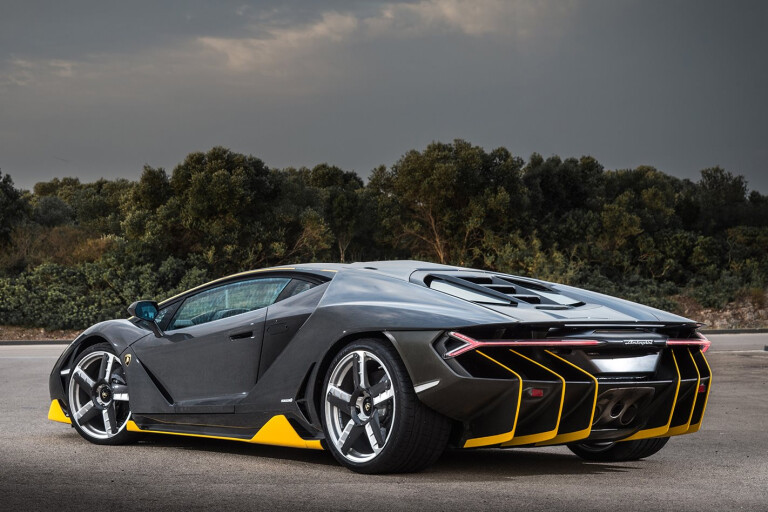
This is not just any old Lamborghini test mule. Glistening in the early morning light is the one and only Centenario prototype, destined to one day head to its final resting place in the factory museum.
Unveiled at the 2016 Geneva Motor Show, the Centenario is a special edition Aventador built to celebrate what would’ve been the 100th birthday of Ferruccio Lamborghini.
It follows the recipe established by the Murcielago-based Reventon of 2007: add some power, dramatically restyle the body, install some future technology and, most importantly, severely limit the build run. Just 40 examples of the Centenario will be built – 20 coupes and 20 roadsters – all of which have been sold.
 Inside the yellow-over-black cabin it feels, unsurprisingly, very similar to an Aventador. Head and leg room are compromised by the low-flying roofline and the extrovert dashboard, bumps beat a constant tattoo on your shoulder blades courtesy of the stiff sports suspension while 12 angry cylinders trumpet a guttural growl and propel you forward with frightening power.
Inside the yellow-over-black cabin it feels, unsurprisingly, very similar to an Aventador. Head and leg room are compromised by the low-flying roofline and the extrovert dashboard, bumps beat a constant tattoo on your shoulder blades courtesy of the stiff sports suspension while 12 angry cylinders trumpet a guttural growl and propel you forward with frightening power.
Our playpen is the wonderful Nardo facility, located north of the town of the same name, nestled right down on the heel of Italy’s boot. Built in the 1970s to create jobs in this poverty-stricken part of the country, the result is an extensive vehicular proving ground that Ben Hur would be proud of. Recently purchased by Lamborghini’s VW Group stablemate Porsche, the facility is used by almost all major European manufacturers.
Cash from Wolfsburg helped renovate the high-speed loop with its fast four-lane banked corners, as well as the magic 6.8km infield handling track that constitutes our course today. Leading the way is Lambo’s gun test driver Mario Fasanetto in an Aventador SV, while lined up his wake are the 566kW Centenario, another 552kW Aventador SV and a ‘base’ 515kW Aventador for reference. All three develop an identical 690Nm of torque, but it’s there the similarities end.
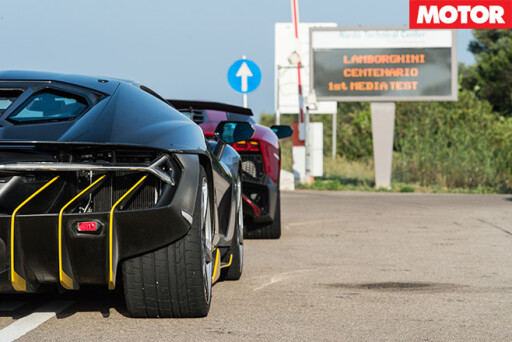 There’s surely no such thing as a bad racetrack, but Nardo is truly exceptional, partly because its main straight is long enough for the latest supercars like the LaFerrari and Bugatti Chiron to top 320km/h. Carry enough momentum out of the last left-hander before the finish line and the Centenario will rapidly reach 175km/h in third, 210km/h in fourth and 275km/h in fifth before a lift for the first corner brings things down to a more manageable 240km/h.
There’s surely no such thing as a bad racetrack, but Nardo is truly exceptional, partly because its main straight is long enough for the latest supercars like the LaFerrari and Bugatti Chiron to top 320km/h. Carry enough momentum out of the last left-hander before the finish line and the Centenario will rapidly reach 175km/h in third, 210km/h in fourth and 275km/h in fifth before a lift for the first corner brings things down to a more manageable 240km/h.
A nice mix of left-and right-handers follows with a number of blind bends later in the lap, but the highlight is one memorable crest where, for a brief moment, only sea and sky fill the frame.
Thankfully, Fasanetto sets the pace and shows us the line, staying out wide towards the middle of the track longer than seems natural and braking hard while firing in downshifts, the big V12 barking its appreciation for his commitment.
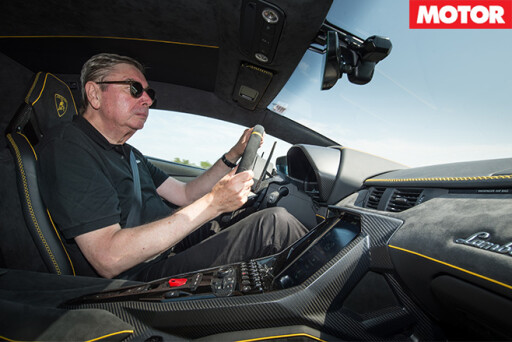 The amateur driver tries to follow: it’s 566kW against Fasanetto’s 552kW, but unless you’re really on it, the SV will pull away at the entrance of the long flat-out section as if assisted by a hidden e-boost device. Nail the exit and it would be possible to pull alongside, but all of a sudden Fasanetto extends his braking point by another two car lengths, which re-opens the gap frustratingly wide.
The amateur driver tries to follow: it’s 566kW against Fasanetto’s 552kW, but unless you’re really on it, the SV will pull away at the entrance of the long flat-out section as if assisted by a hidden e-boost device. Nail the exit and it would be possible to pull alongside, but all of a sudden Fasanetto extends his braking point by another two car lengths, which re-opens the gap frustratingly wide.
It’s obvious the key dynamic feature which distinguishes Centenario from SV are the adaptive aerodynamics. The Centenario sucks in oxygen through the nose cone, small apertures below the headlamps and large lateral scoops.
The air enters the car via the front radiator and wheelarches or flows over the smooth roof, along the sculptured flanks and from the front splitter to the rear diffuser. The adjustable rear wing assumes a near-horizontal position for high-speed runs, but when necessary it can increase downforce by up to 180 per cent.
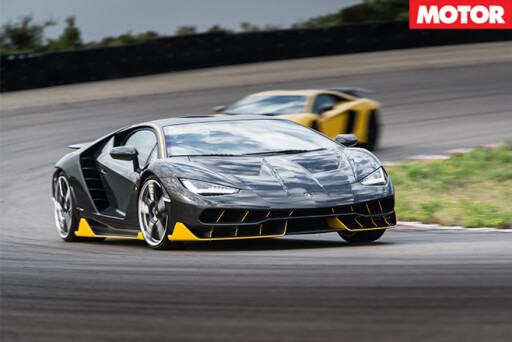 Here at Nardo, aerodynamic stability makes all the difference between grip and slip. Through the ultra-fast balls-out corners, the Centenario often gains a metre or two simply for this reason.
Here at Nardo, aerodynamic stability makes all the difference between grip and slip. Through the ultra-fast balls-out corners, the Centenario often gains a metre or two simply for this reason.
Sant’Agata’s latest mauler is a manifesto of excess, best quantified in raw numbers. The biggest of these is the price. Each of the 20 coupes listed at €2.2m (AUD$3.24m), the 20 roadsters €2.4m (AUD$3.54m) apiece, while the full carbon pack is €100K (AUD$147K) extra.
For any normal person that might sound ridiculous for what is essentially an Aventador playing Darth Vader dress-ups, but it’s peanuts for the ultra-high net worth individuals with hangar-sized garages who are Lamborghini’s favoured clientele.
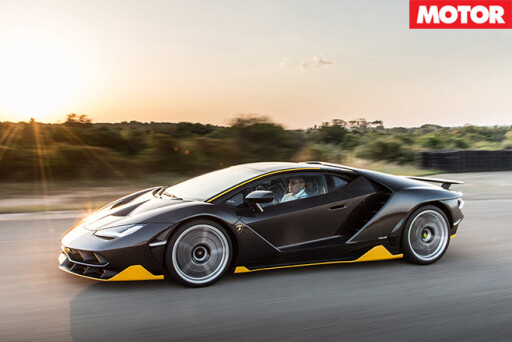 The Centenario might not be able to go blow-for-blow with the latest hypercars, but nought to 300km/h still takes just 23.5sec, the 1520kg dry weight ensuring a power-to-weight ratio of 372kW/tonne.
The Centenario might not be able to go blow-for-blow with the latest hypercars, but nought to 300km/h still takes just 23.5sec, the 1520kg dry weight ensuring a power-to-weight ratio of 372kW/tonne.
Combined with monster carbon-ceramic brakes that haul the beast up from 100km/h in a highly physical 30 metres, there’s credence to the rumour that the Centenario has set a Nurburging lap record, shaving a few seconds off the Aventador SV’s mind-blowing 6min57sec lap.
More importantly, the Centenario offers a clear glimpse into the future, with its key ingredients to be carried over to the updated 2018-model Aventador. According to those in the know, the active flaps and rudders will further reduce drag resistance, the 552kW SV engine will likely become the mainstay powerplant and the brand-new touchscreen infotainment system pioneered by the Centenario will make its way into all future Lambos.
 The most significant chassis revision is rear-wheel steering, which is expected to join the list of standard features. The system turns the rear wheels in the opposite direction to the fronts at slow speed and in the same direction at high speed, to a maximum of three degrees.
The most significant chassis revision is rear-wheel steering, which is expected to join the list of standard features. The system turns the rear wheels in the opposite direction to the fronts at slow speed and in the same direction at high speed, to a maximum of three degrees.
Around town and through slow corners, the car now feels shorter, nimbler and more manoeuvrable. On the freeway, enhanced directional stability is the main benefit.
Lapping Nardo in the Centenario (and the SV), the advantages of rear-wheel steering are immediately evident and it would have a profound effect on the desirability of the base Aventador. Turn-in is much quicker, sharper and more positive, though the playfulness at the limit has been scaled back. In exchange you get a more focused and much faster cornering attitude.
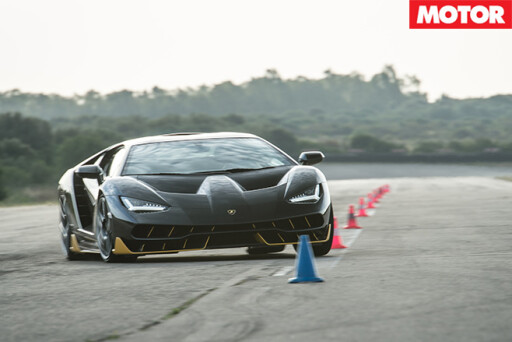 How much faster? The difference between the two rear-steer protagonists over a lap is a scant 1.5sec, but the base 515kW variant loses up to five seconds due to more pronounced understeer caused by the front tyres heating up quicker.
How much faster? The difference between the two rear-steer protagonists over a lap is a scant 1.5sec, but the base 515kW variant loses up to five seconds due to more pronounced understeer caused by the front tyres heating up quicker.
Although the 566kW Centenario is no quicker off the mark than the 552kW SV (Lamborghini claims both manage 0-100km/h in 2.8sec), its overall set-up is more aggressive. The marginally faster flow through the corners is evidence of the steel rather than rubber chassis mounts, meaner shock absorber software and the suction-cup effect of the active aerodynamics. Despite the flamboyant Death Star looks, the gestures which accompany the Centenario’s dynamic performance are actually quite restrained.
Although this set-up knocks off a tenth here and there, not everyone may appreciate the added firmness and directness that is part of the go-faster kit. Unlike the more modern ANIMA-equipped Huracan, the Aventadors want you to dial in the preferred drive mode – Strada, Sport or Corsa – by pushing a button in the centre stack.
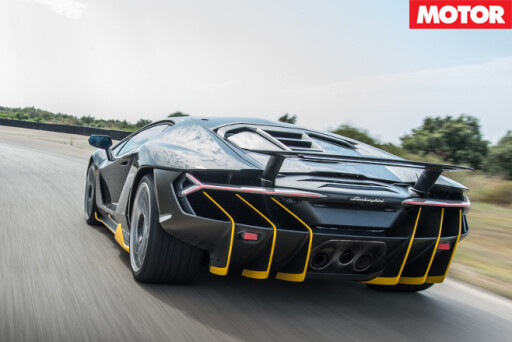 There’s not really any effect to the steering response between the modes, however, there are other differences and you can’t mix-and-match elements to your liking.
There’s not really any effect to the steering response between the modes, however, there are other differences and you can’t mix-and-match elements to your liking.
While Strada has been labelled by marketing as the ‘take me home’ function, Sport is all about ‘fun and emotion’. That’s Lamborghini-speak for a rear-bias torque split and more lenient traction control tuned to allow a quick flick of opposite lock, necessary thanks to a dash of lift-off oversteer or a hint of full-throttle tailslide. Even with plenty of runoff terrain, it takes a brave person to fully deactivate DSC.
Somewhat unexpectedly, Corsa mode is somewhat of a stealth proposition, dedicated to greater perfection and less emotion. Expect quantifiably faster lap times (the Centenario features an in-dash stopwatch and two on-board cameras), a less heroic but no less rewarding driving style and a subtly enhanced dynamic efficiency.
 In Corsa, upshifts kick with vengeance, downshifts move closer to the redline and throttle response is telepathically prompt. There is no torque vectoring to fine-tune the line, no fancy new driver assistance systems and no active roll bars. This is a high-end sports car in its raw form without any artificial additives and preservatives.
In Corsa, upshifts kick with vengeance, downshifts move closer to the redline and throttle response is telepathically prompt. There is no torque vectoring to fine-tune the line, no fancy new driver assistance systems and no active roll bars. This is a high-end sports car in its raw form without any artificial additives and preservatives.
Flaws? The ISR gearbox’s hesitant automatic mode is still unbecoming of a car of this type, visibility is only clear in one direction, the redesigned pseudo race-car instrument binnacle cannot match a head-up display for clarity and the occasionally rough ride isn’t a charming experience.
We started driving at six in the morning and kept going until the track was closed at midday. Three days later, the neck still hurt and the bum was a bruised reddish hemisphere, but the glowing memories of the Centenario remained.
 The attraction of Lamborghini’s latest creation can’t be reduced to descriptions of presence, image, personality and power. The Centenario’s appeal lies in its status as the ultimate challenge, its attractions are traits like noise, heat, harshness and space limitation.
The attraction of Lamborghini’s latest creation can’t be reduced to descriptions of presence, image, personality and power. The Centenario’s appeal lies in its status as the ultimate challenge, its attractions are traits like noise, heat, harshness and space limitation.
No, this car is not the right choice for cool, analytical types. But the shrill looks, the eye-watering full-throttle urge and the exciting escapes to the limit make it an irresistible proposition to purists.
 4.0 OUT OF 5 STARS
4.0 OUT OF 5 STARS
LIKES: More power; less weight; new tech
DISLIKES: Crazy pricetag; harsh ride
SPECS
Body: 2-door, 2-seat coupe
Drive: all-wheel
Engine: 6498cc V12, DOHC, 48v
Bore/stroke: 95.0 x 76.4mm
Compression: 11.8:1
Power: 566kW @ 8500rpm
Torque 690Nm @ 5500rpm
Power/weight: 372W/tonne (dry)
Transmission: 7-speed automated manual
Weight: 1520kg (dry)
Suspension(f): double A-arms, adaptive dampers, anti-roll bar
Suspension(r): double A-arms, adaptive dampers, anti-roll bar
L/W/H: 4924/2062/1143mm
Wheelbase: 2700mm
Tracks: 1720/1680mm (f/r)
Steering: hydraulically-assisted power steering
Brakes(f): 400mm ventilated/drilled carbon-ceramic discs, 6-piston calipers
Brakes(r): 380mm ventilated/drilled carbon-ceramic discs, 4-piston calipers
Wheels 20 x 9.0-inch (f); 21 x 13.0-inch (r)
Tyre sizes: 255/30 ZR20 (f); 355/25 ZR21 (r)
Tyre: Pirelli P Zero
Price as tested: €2.2 million (approx AUD$3.22 million)

COMMENTS